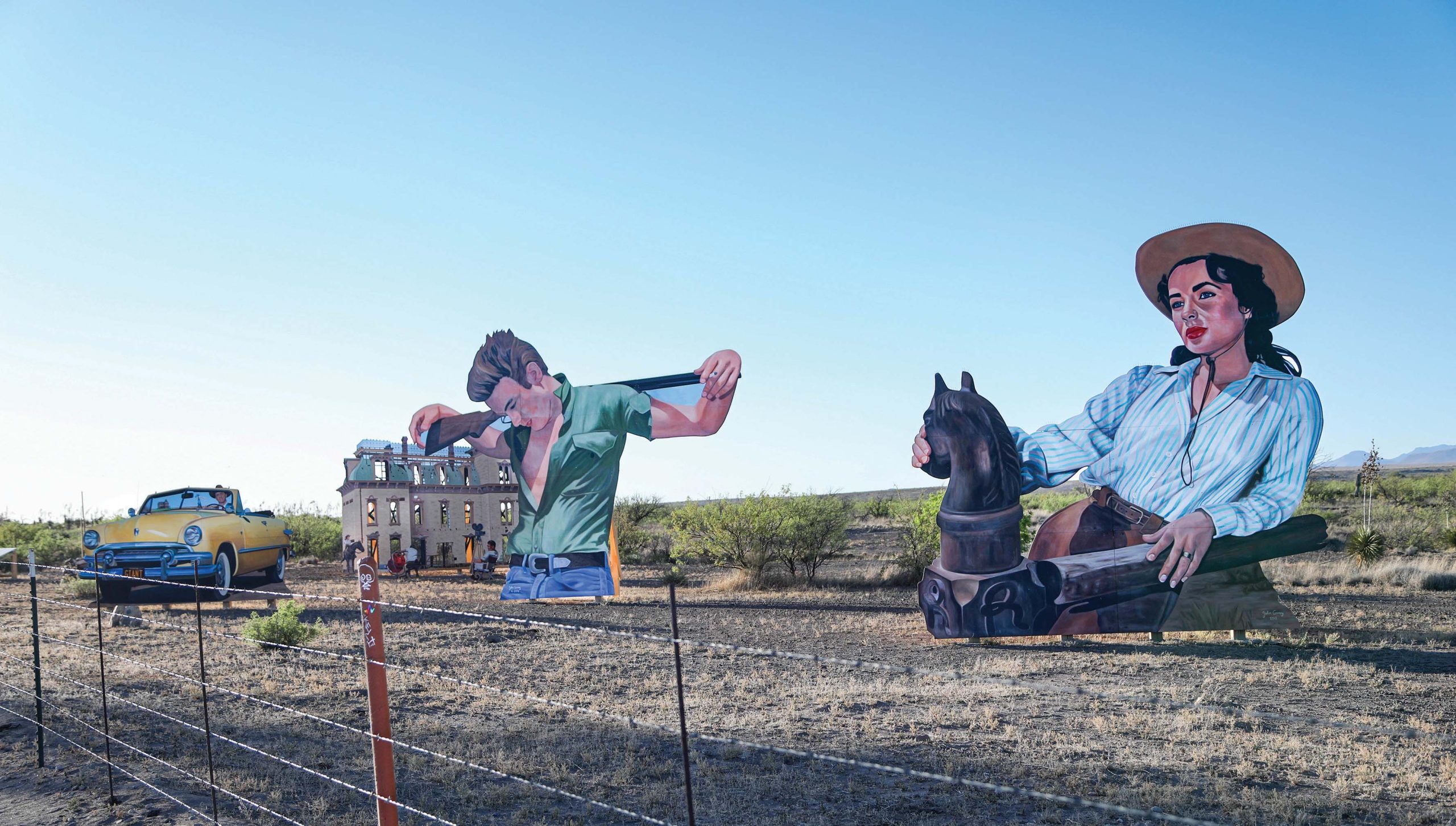
06 Sep Wanderings: Art Pilgrimage
Marfa, Texas, is a long way from anywhere, and therein lies its attraction. When minimalist artist Donald Judd first visited in the 1970s, he was struck by the remoteness, the pace of life, the desert air, and, of course, the quality of light. It was also the affordability and suitability of available real estate. When he discovered how those things affected his art — and how the place would allow him to create on the scale he saw in his mind’s vision and display work as he meant it to be displayed — Judd, an international art-world superstar then based in New York, moved to West Texas.
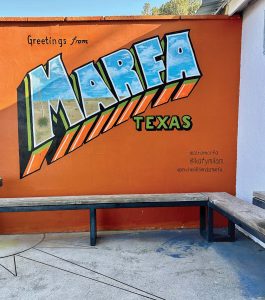
In town, a hand-painted sign indicates the beauty of the light and the artistry found at every turn. | Photos: Missy Jane
Originally a Spanish-American War-era frontier town, and later a commercial hub for the wool and cattle industry, when Judd arrived, the Army base was disused and the town was in decline. Backed by the DIA Foundation, he bought the base and turned it into a museum, which is now run by the Chinati Foundation.
Inside two renovated armories, Judd installed his magnum opus, 100 identically scaled aluminum boxes, each with one unique variation. The installation, bathed in light from enormous windows on both sides, is breathtaking, and explains the artist’s obsession with art being experienced in its place. Meanwhile, Judd invited contemporaries and friends to Marfa; other buildings on site house works by Dan Flavin, John Chamberlain, Claes Oldenburg, Richard Long, and Robert Irwin.
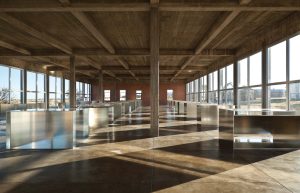
The biggest art influence in Marfa was midcentury superstar Donald Judd, who first visited the town in the 1970s. Enamored with the quiet and sense of space, Judd created large-scale, site-specific works, including installing 100 aluminum boxes in two renovated armories on a former Army base at the edge of town, now operated by the Chinati Foundation. Donald Judd, 100 Untitled Works in Mill Aluminum, 1982-1986. Permanent collection, The Chinati Foundation, Marfa, Texas. | Photo by Douglas Tuck, courtesy of The Chinati Foundation. Donald Judd Art ©2024 Judd Foundation / Artists Rights Society (ARS), New York.
Judd also purchased buildings in Marfa’s historic downtown — houses, an old bank, a former Safeway — developing them into workshops and live-work spaces for himself and his young family. Judd even had a ranch outside Marfa — and plans for many more projects besides — before his untimely death in 1994 at age 65. Today, his home, studio, library, and eclectic art collection are maintained by the Judd Foundation.
Marfa had long been on my bucket list when I assembled a group of art-minded friends to make the pilgrimage, which began with a three-hour drive from El Paso through the Chihuahuan Desert. Although it was spring — with flowering cacti and prairie wildflowers in yellow, lavender, and pink sprinkling the open plains — there were few visible signs of life: some hawks, one band of cattle, and the occasional lone antelope. The effect is full disconnect.
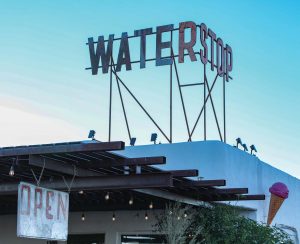
Fun and funky eateries and boutiques dot the streets of this beautifully preserved railroad town. | Photo: Missy Janes
Then, by the side of the road, you come upon a Prada ‘store’ fully stocked with shoes and handbags surrounded by scrubland. Even if you’ve seen photos of Prada Marfa, the installation created by Scandinavian artists Elmgreen & Dragset — which you undoubtedly have given its popularity with influencers, in fact, a leather-clad couple was indulging in selfies when we arrived — this provocative statement about commercialism is still striking.
The next Marfa set piece looms 8 miles west of town, where artist John Cerney created an installation dedicated to the 1956 movie “Giant,” which was shot in Marfa and starred Elizabeth Taylor, Rock Hudson, and James Dean. The artwork consists of monumental billboards of the actors, house, and taxi-yellow convertible featured in the film, with country music playing from hidden speakers. It’s weirdly endearing, and it neatly sets you up for “The Marfa Experience,” which is, of course, all about the art.
There are many Marfas. Judd’s Marfa can be experienced through a series of in-depth tours offered by the Chinati and Judd foundations, all highly recommended and fascinating. Judd-adjacent Marfa experiences include such artworks as Andy Warhol’s massive painting of the Last Supper on permanent display at the Ayn Foundation, a dedicated gallery space.
Marfa is also full of working artists, both residents and visitors. Studio tours can be arranged or occur by happenstance. Wandering the streets, we step into Arber & Son Editions. Robert Arber and his wife followed Judd to Marfa half a century ago. They bought a movie theater, turning the projection room into their bedroom, and the downstairs into a printmaking studio and gallery. Today, they represent local artists and collaborate with many. (We missed seeing Sofia Coppola there by only a few weeks). Arber shares some exceptional artwork and stories, including one about his plan with Judd to bottle sotol, a regional elixir with magical properties, in glass art bottles.
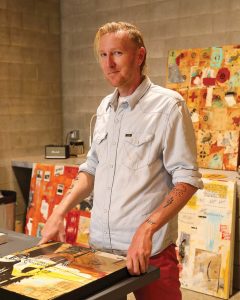
Multi-media artist Miles Glynn recently relocated from Montana to Marfa. In keeping with the town’s welcoming and laid-back atmosphere, his studio, Westernish, is open to the public.
During our trip, we visit artist Miles Glynn’s studio, Westernish. The concrete-floored former garage has big doors flung open to the public. His colorful, oversized mixed-media works are exuberant and fun, containing layered messages about the iconography and tropes of the West.
Glynn sends us to meet his friends Sabrina Lejeanvre and Jeff Matheis at their home, studio, exhibition space, and sculpture park, MAINTENANT, located in the open country next to cattle pasture. The pair curates exhibitions and hosts performances featuring local artists, friends, and established visiting artists.
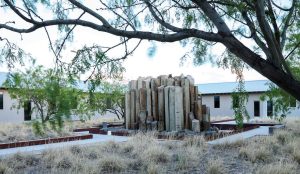
One of the most powerful art installations in Marfa is the Chinati Foundation’s large-scale Robert Irwin artwork, untitled (Dawn to Dusk) 2016, an entire building whose interiors are defined by color and light play.
The population explodes exponentially over the two major art weekends: Marfa Invitational, typically held at the start of summer, and Chinati Weekend, held in October. Yet, the town feels sparsely inhabited. This, combined with trains running through the middle of town and the ubiquity of well-maintained buildings, gives Marfa the feel of a stage set. With a little downtime, we wander the main street, which terminates at the handsome courthouse. Each building is a photo op, its outline etched against the brilliant blue sky. Many commercial establishments don’t necessarily read as open to the public, their signs understated or obscured, which only adds to the dreamlike feeling.
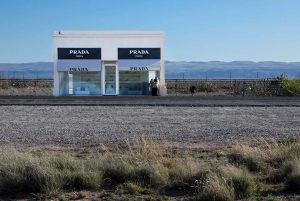
The oft-Instagrammed Prada Marfa ‘store,’ surrounded by an austere desert landscape, was installed at the side of the highway by Scandinavian artists Elmgreen & Dragset in 2005. | Photos: Missy Janes
Collectible trucks and cars are plentiful, parked in front of stores or driveways; vintage trailers are ubiquitous. Meanwhile, everywhere you look, Marfa’s artists show their hands in fun, funky artistic details, like a zigzag pattern formed by glass bottles wedged into the gaps in a chain link fence, or an empty corner lot dotted with junkyard sculpture. Scattered palm trees, cactus gardens, a white water tank with “Marfa” lettered in black, and the dome of the courthouse all establish a sense of place.
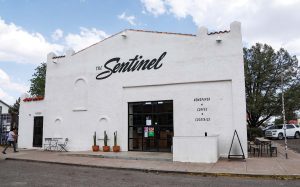
The Sentinel houses a restaurant, bar, and shop featuring local goods, in addition to being the home to the local newspapers, The Big Bend Sentinel and Presidio International.
Marfa’s spirit is friendly, and its hospitality is professional if free-spirited. This means coffee shops, boutiques, and galleries come and go, change hours, or are open by appointment only, making it a go-with-the-flow kind of place. This town’s population is less than 2,000, but there are numerous places to buy a $5 latte and spectacular meals abound.
The first morning, we try The Sentinel, with its airy open spaces, indoor-outdoor seating, hand-baked goods, and a perfect brew topped with crema art reverently served in heavy, hand-thrown vessels. We intend to return for their celebrated evening bar scene, but we never make it because we’re trying, and failing, to frequent every establishment. Marfa’s dining options range from street-style tacos to bison burgers, from highly localized and seasonal dishes to elevated international fare like escargots. At Cochineal, for example, after specialty cocktails, snails were served sans shells in a thick, creamy, garlicky nectar, to be sopped up with garlic bruschetta.
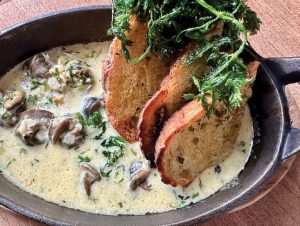
Marfa is an international crossroads of sorts, with food — and art — ranging from the rustic to the sublime.
After a day of being sensorily overloaded with fabulous art in the West Texas heat, Hotel Saint George, which opened in 1886 as a railroad stop, offers respite. The George’s pool and, more importantly, its poolside bar, are open to the public every afternoon, just as the mercury hits the high notes. It’s a languid hipster scene, with signature cocktails and comfortable seating areas to encourage lingering. While waiting for our tequila-based libation, a friendly 20-something wearing a bikini bedecked with iridescent beaded fringe offers to share her fruity alcoholic smoothie.
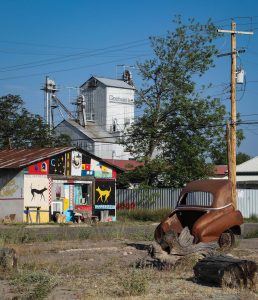
The town is rife with colorful artistic flourishes and iconic vernacular architecture seen in local landmarks like the town’s grain elevator. | Photos: Missy Janes
Between art tours, in a spirited bid to boost Marfa’s art-based economy, we sample quirky boutiques like Hey I Like it Here, with offerings of local artisan-made goods, books, and clothes. Over the course of the trip, someone buys a straw cowboy hat, another a silk kerchief with a silver scarf slide, yet another a hair-on-cowhide clutch.
There’s also plenty to do outside of town, including Fort Davis National Historic Site. It’s a well-preserved cavalry outpost from the American Indian Wars, with a row of officer’s quarters neatly lined up under a phalanx of vertical cliffs, a few horses grazing in an open pasture. After hiking in Davis Mountains State Park, we stop at a market for lunch. We buy note cards featuring dramatic landscape photography of rock outcrops and cloud formations. Our cashier offers to sign them; naturally, he is the artist.
One evening, we drive 9 miles east of town to the Marfa Lights Viewing Area, an elevated platform with views facing southeast. These mystery lights contribute to the town’s ‘Magical Marfa’ moniker. The phenomenon, which has been reported since the 19th century, maybe occurs sometimes, and may or may not be caused by atmospheric reflections of campfires and headlights from a distant highway. We went, we hung out with other hopefuls; after an hour we shrugged good-naturedly and went to dinner.
Marfa is a destination in every sense of the word, chock-full of well-preserved regional architecture, a layered history, and elevated, interesting amenities that are outsized for its location. For visitors who make the trek, and for the artists who live there, Marfa is endlessly inspiring and utterly unique. Miles Glynn, a Texas native, had been making art in Montana before relocating to Marfa last year. “There are so many levels to the art scene here,” he explains. “You have people making crazy desert folk art, then you have the Max Hetzler gallery, whose other locations are Berlin, London, and Paris, bringing people from Europe all the time. So you have extremes from the lone artist out in the desert to the Hetzler Gallery and everything in between. And then you have Donald Judd, looming over everything.”
When one arrives, its appeal — to Judd and those who followed him — is obvious. “Marfa,” says art consultant Pamela Bingham, “allowed Judd to do everything he wanted to do.” Thanks to his vision and those who supported it, this art-centric outpost in the West Texas desert will continue to attract generations of artists, aficionados, and adventurers.
Art Inspo
Check out these and other artistic attractions in Marfa, Texas.
Prada Marfa: Located 37 miles west of Marfa, this installation work commissioned by Ballroom Marfa and created by artists Elmgreen & Dragset has become a must-photograph opportunity for influencers and hipsters. ballroommarfa.org/archive/prada-marfa-an-explainer
Homage to “Giant”: This multi-piece mural of the hit movie was created by artist John Cerney and is located five minutes from Marfa on Highway 90. johncerneymurals.com
Judd Foundation Tour: Tour Donald Judd’s residence and studio spaces Tuesday through Sunday. 432.729.4406; juddfoundation.org
The Chinati Foundation/La Fundación Chinati: At the center of the Chinati Foundation’s permanent collection are 100 untitled works in mill aluminum by Donald Judd, installed in two former artillery sheds. Explore these and additional works by Judd and other noted artists during a guided tour offered twice daily. Advance reservations are encouraged. 432.729.4362; chinati.org
Sleeping Figure: This 150-foot-long, 40-foot-tall sculpture of a figure in repose is made completely out of shipping containers. Constructed by L.A. artist Matt Johnson for Desert X in Palm Springs, it was relocated to land owned by Marfa Invitational. mattjohnson.la
stone circle: Ballroom Marfa commissioned this large stone circle from Haroon Mirza in 2018. Located in open grasslands east of Marfa, it’s open to the public during Ballroom Marfa’s gallery hours. ballroommarfa.org/stone-circle
MAINTENANT Marfa: Check in with this indoor-outdoor gallery and event space for artwork, boxing, music, film, writing, furniture, and design. maintenantmarfa.com
Chinati Weekend: In October 1987, Donald Judd began the tradition of Chinati Weekend by inviting friends and colleagues to Chinati for a weekend of open viewing, special exhibitions, talks, music, and more. The 37th annual event takes place October 11-13. chinati.org/chinati-weekend
If you go…
Stay / Dine
Hotel Paisano
432.729.3669; hotelpaisano.com
Hotel St. George
432.729.3700; marfasaintgeorge.com
Asters Cafe and Bakery
432.295.0833; asterscafeandbakery.com
Cochineal
432.729.3300; cochinealmarfa.com
The Sentinel Marfa
432.729.7009; thesentinelmarfa.com
Attractions
Big Bend National Park
Davis Mountains State Park
432.426.3337; tpwd.texas.gov/state-parks/davis-mountains
Fort Davis National Historic Site
Marfa Lights Viewing Station
University of Texas McDonald Observatory
432.426.3640; mcdonaldobservatory.org
Shopping
Cosmico
Cobra Rock Boot Company
Garza Marfa
Hey I Like It Here
432.729.3700; heyilikeithere.com
WRONG Store
Based in Northern California, Chase Reynolds Ewald has written about design, food, art, travel, and rustic style for 30 years. Her 17+ books include Cabin Style, At Home in the Wine Country, Wild Sugar, and the award-winning Bison: Portrait of an Icon. Find her @chasereynoldsewald and chasereynoldsewald.com.






No Comments